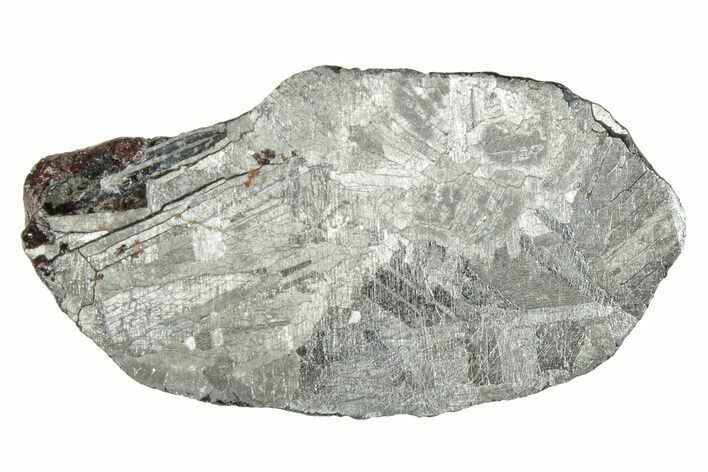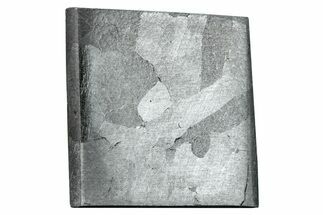1.26" Mundrabilla Iron Meteorite Section (16.7 g) - Australia
This is a 1.26" wide (16.7 gram) Mundrabilla iron meteorite from Western Australia. It has been cut and polished to reveal its stunning interior Widmanstätten patterns.
The Mundrabilla Meteorite
The Mundrabilla meteorite is a famous IAB (ungrouped) iron meteorite that fell in a remote area of Western Australia known as the Nullarbor Plain. It is one of the largest meteorites ever found: over 22 metric tons have been recovered since its discovery, and the main mass itself is over 12 tons!
Mundrabilla has a long history of findings, classifications, and reclassifications. The first pieces were found in 1911 while building a transcontinental railway route on the Nullarbor Plain. They were called Premier Downs I and II for the nearby station. More and more fragments, all of nearly identical composition, were found in the area until the two largest masses (12.4 and 5.4 metric tons, respectively) were discovered by geologists on a survey in 1966. They were about 200 meters apart, surrounded by numerous smaller iron fragments. These two main masses connected all the dots: upon study, most all of the smaller fragments found since 1911 were part of this larger meteorite, which was named Mundrabilla. The main mass, named Mundrabilla I, is the thirteenth-largest meteorite mass in the world. It is on display at the Western Australian Museum in Perth.
Mundrabilla is known for its interesting shapes and thumbprint-like regmaglypts, caused by parts of the meteorite melting away as it traveled through Earth’s atmosphere. It is about 65 to 75% iron-nickel by volume, and even contains a superconductive alloy of tin, lead, and the rare metal indium. Unless cleaned, all pieces have an orange patina.
The recovery site is now a protected area and collecting is forbidden. Any Mundrabilla material on the market is limited to old collection material.
The Mundrabilla meteorite is a famous IAB (ungrouped) iron meteorite that fell in a remote area of Western Australia known as the Nullarbor Plain. It is one of the largest meteorites ever found: over 22 metric tons have been recovered since its discovery, and the main mass itself is over 12 tons!
Mundrabilla has a long history of findings, classifications, and reclassifications. The first pieces were found in 1911 while building a transcontinental railway route on the Nullarbor Plain. They were called Premier Downs I and II for the nearby station. More and more fragments, all of nearly identical composition, were found in the area until the two largest masses (12.4 and 5.4 metric tons, respectively) were discovered by geologists on a survey in 1966. They were about 200 meters apart, surrounded by numerous smaller iron fragments. These two main masses connected all the dots: upon study, most all of the smaller fragments found since 1911 were part of this larger meteorite, which was named Mundrabilla. The main mass, named Mundrabilla I, is the thirteenth-largest meteorite mass in the world. It is on display at the Western Australian Museum in Perth.
Mundrabilla is known for its interesting shapes and thumbprint-like regmaglypts, caused by parts of the meteorite melting away as it traveled through Earth’s atmosphere. It is about 65 to 75% iron-nickel by volume, and even contains a superconductive alloy of tin, lead, and the rare metal indium. Unless cleaned, all pieces have an orange patina.
The recovery site is now a protected area and collecting is forbidden. Any Mundrabilla material on the market is limited to old collection material.
About Iron Meteorites
Iron type meteorites are composed primarily of iron and nickel, and are the remnants of differential cores torn apart at the beginning of the solar system. These metallic meteorites are often the easiest to identify after millions of years post-impact because they are quite different from terrestrial material, especially when it comes to their mass-to-surface area ratio. They are exceptionally heavy for their size since iron is a high-density metal: this is also why the Earth's core is nickel-iron. As planets form, the densest metals form gravitational centers, bringing more and more material into their gravitational pull. In the solar system's rocky planets, these dense materials are most often nickel and iron.
Most iron meteorites have distinctive, geometric patterns called Widmanstätten patterns, which become visible when the meteorite is cut and acid etched. These patterns are criss-crossing bands of the iron-nickel alloys kamacite and taenite that slowly crystalized as the core of the meteorites' parent bodies slowly cooled. Such large alloy crystallizations for mover millions of years and do not occur naturally on Earth, further proving that iron meteorites come from extraterrestrial bodies.
Iron type meteorites are composed primarily of iron and nickel, and are the remnants of differential cores torn apart at the beginning of the solar system. These metallic meteorites are often the easiest to identify after millions of years post-impact because they are quite different from terrestrial material, especially when it comes to their mass-to-surface area ratio. They are exceptionally heavy for their size since iron is a high-density metal: this is also why the Earth's core is nickel-iron. As planets form, the densest metals form gravitational centers, bringing more and more material into their gravitational pull. In the solar system's rocky planets, these dense materials are most often nickel and iron.
Most iron meteorites have distinctive, geometric patterns called Widmanstätten patterns, which become visible when the meteorite is cut and acid etched. These patterns are criss-crossing bands of the iron-nickel alloys kamacite and taenite that slowly crystalized as the core of the meteorites' parent bodies slowly cooled. Such large alloy crystallizations for mover millions of years and do not occur naturally on Earth, further proving that iron meteorites come from extraterrestrial bodies.
TYPE
Iron, IAB (Ungrouped)
LOCATION
Western Australia, Australia
SIZE
1.26 x .68 x .34", Weight: 16.7 grams
CATEGORY
ITEM
#280633
 Reviews
Reviews









